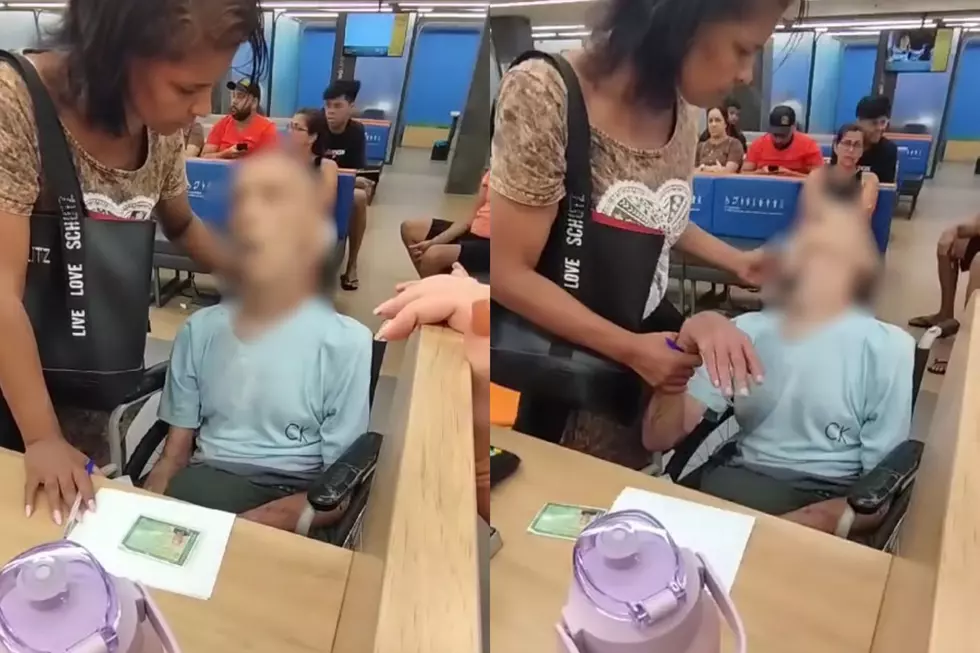
President Trump Scored Perfect on Cognitive Assessment, Can You?
The President received a perfect score of 30 on the Montreal Cognitive Assessment, a test created to look for dementia. Here are the questions so you can test yourself or your friends.
If you want to truly test your cognitive ability, have somebody else read this test for you.
For a point of reference, Dwyer was instructed to draw a clock and to set the hands to 10 after 11. After administering this test to him, I've come to the conclusion that he's a lunatic. Here's his clock drawing:
ALTERNATING TRAIL MAKING – five points
TASK ONE: Match five numbers (1-5) with five letters (A-E) in ascending order (pairing 1 with A, 2 with B, etc).
The subject gets a point for every successful pair. No lines can be crossed. The patient gets 0 if they make a mistake that is not immediately corrected.
TASK TWO: Draw your own version of the cube in the space next to it. It must be exactly the same as the one printed on the page.
You get one point if it’s drawn correctly. That means it must be three-dimensional with no lines missing or added, the lines must be relatively parallel and similar in length. No point is given if any of those criteria are missing).
TASK THREE: Draw a clock, including all of the numbers, and set the time to 10 minutes past 11.
One point is allocated for each of the following three criteria:
- Contour - The clock face must be a circle with only minor distortion acceptable (i.e. slight imperfection on closing the circle).
- Numbers - All clock numbers must be present with no additional numbers; numbers must be in the correct order and placed in the approximate quadrants on the clock face. Roman numerals are acceptable. Numbers can be placed outside the circle contour.
- Hands - There must be two hands jointly indicating the correct time; the hour hand must be clearly shorter than the minute hand. Hands must be centered within the clock face with their junction close to the clock center.
A point is not assigned for a given element if any of the above-criteria are not met.
NAMING – three points
TASK: Name each animal pictured. One point is received for each animal correctly named: Lion, Rhinoceros (or rhino), Camel (or dromedary)
MEMORY – one point is deducted for each missing word
TASK: The patient is read a list of words that they must remember and they must repeat as many of the words as they can recall, in any order they like.
The examiner then reads five words out loud at a rate of one per second: FACE, VELVET, CHURCH, DAISY, RED.
As the subject recites the words, the examiner marks a check in the box for each word recalled before the subject indicates when they have recited all they can.
The test is repeated twice.
ATTENTION – six points
TASK ONE: The subject is read a list of numbers at a rate of one number per second. They must then recite them in forward order for one point and backwards order for a second point.
TASK TWO: The subject is read a list of letters “F B A C M N A A J K L B A F A K D E A A A J A M O F A A B” at a rate of one per second. Every time they hear the letter “A”, they must tap their hand.
TASK THREE: Starting at 100, the subject is asked to count down by subtracting by seven every time until the examiner tells them to stop.
The subject starts at 100, then must count down by subtracting seven every time, until the examiner tells them to stop, ie: “93, 86, 79, 72, 65 ...”
No points are given if there are no correct subtractions. One point is given for just one correct subtractions and two or three correct subtractions earns two points.
LANGUAGE – three points
TASK ONE: The examiner reads the following sentence out loud: “I only know that John is the one to help today” and the subject must repeat it exactly.
The test is repeated with a second sentence: “The cat always hid under the couch when dogs were in the room”.
One point is given for each sentence repeated absolutely verbatim.
TASK TWO: The examiner reads out a letter (F), and the subject has to think of as many words as they can that begin with that letter. The aim is to reach 11 words or more in 60 seconds. The words cannot be proper nouns, such as names of people or places, or the same word with different suffixes (eg: live, lived, living).
One point is given if 11 or more words are listed within one minute.
ABSTRACTION – two points
TASK: The patient has to describe what certain pairs of words have in common (e.g, an orange and a banana; a train and a bicycle; a ruler and a watch). One point is given for each of the last two pairs.
For example an acceptable answer would be to describe a train and a bicycle a forms of transport but an unacceptable answer would be to say they both had wheels.
DELAYED RECALL – five points
TASK: The subject has to recall all the words they heard earlier (FACE, VELVET, CHURCH, DAISY, RED).
One point is granted for each word remembered without prompting.
ORIENTATION – six points
TASK: The subject is asked to state the present date, month and year, and the name of the place they are in as well as the city.
One point is given for each correct answer.
WHAT YOUR SCORE MEANS
(Those who have had less than 12 formal years of education should add one point to their final score).
Around 16: cognitive health of an Alzheimer’s sufferer.
Around 22: cognitive health of someone with mild cognitive impairment (MCI)
Above 26: Normal
30: Perfect (the same as President Trump).
More From 97X









